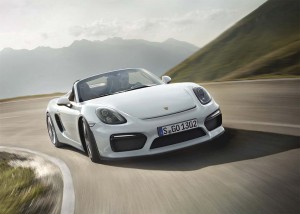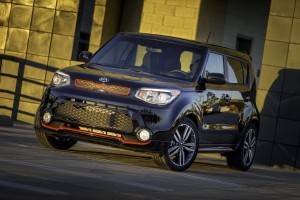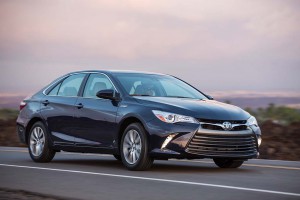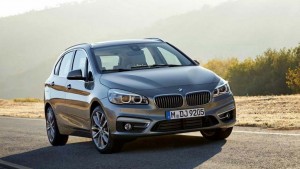
Porsche captured the top spot in J.D. Power's most recent Initial Quality Survey. The Boxster is the top choice in the compact sporty car category.
While fuel economy, design and performance are three of the factors that heavily influence the vehicles Americans choose when they go to the showroom, quality is often the deciding factor. The good news is that today’s cars, trucks and crossovers deliver better quality than ever, according to the latest J.D. Power Initial Quality Study.
Just two decades ago, the average vehicle was likely to suffer from as many as three to four “problems” during the first 90 days of ownership, early surveys revealed. But in the latest Power IQS, that’s down to barely one. And among the best models, many owners may find nothing to complain about at all while even the worst vehicles today would have been at the top of the chart at the turn of the Millennium.
The 2015 Initial Quality Survey delivered some big surprises. For one thing, Kia was the second-ranked brand overall, behind only Porsche, and ahead of all the traditionally high-quality Japanese makers. Hyundai, at fourth, also led traditional quality benchmarks Lexus, Toyota and Honda. But which individual models topped the chart?
Based on surveys filled out by 84,000 motorists who bought or leased a new 2015 vehicle, the IQS looks at the defects – “problems,” in Power’s lingo – they experienced during the first 90 days of ownership. On the whole, initial quality rose about 3% compared to the 2014 model-year, though that varied by brand and model.
(Japanese automakers slide as Koreans make quality gains, according to Power quality survey. For more, Click Here.)

Kia claimed second place in the Power quality survey, including the Kia Soul claiming the top spot in the compact multipurpose vehicle category.
The annual study the market up into 26 segments, 13 for passenger cars and an equal number for trucks, vans, pickups and what Power labels MPVs. Here are the top models by segment. (Note that most categories include three vehicles, but in a few segments only one model performed above industry average.)
City Car: Highest Ranked was the Chevrolet Spark.
Small Car: Highest Ranked was the Hyundai Accent, followed by the Kia Rio and Chevrolet Sonic.
Small Premium Car: Highest Ranked was the BMW 2-Series, followed by the Acura ILX.
Compact Car: Highest Ranked was the Nissan Sentra, followed by the Hyundai Elantra and, in a tie, the Toyota Corolla.
Compact Sporty Car: Highest Ranked was the Mazda MX-5 Miata, followed by the Volkswagen EOS and Scion tC.
Compact Premium Car: Highest Ranked was the BMW 4-Series, followed by the Lincoln MKZ and Lexus ES.
Compact Sporty Car: Highest Ranked was the Porsche Boxster, followed by the Porsche Cayman.
Midsize Car: Highest Ranked was the Chevrolet Malibu, followed by the Kia Optima and the Toyota Camry.
Midsize Sporty Car: Highest Ranked was the Dodge Challenger, followed by the Chevrolet Camaro.
Midsize Premium Car: Highest Ranked was the BMW 5-Series, followed by the Lincoln MKS and Infiniti Q70.
Midsize Premium Sporty Car: Highest Ranked was the Porsche 911, followed by the Mercedes-Benz SL and the Jaguar F-Type.
Large Car: Highest Ranked was the Chrysler 300, followed by the Kia Cadenza and Chevrolet Impala.
Large Premium Car: Highest Ranked was the Lexus LS, followed by the BMW 7-Series and Porsche Panamera.

Toyota earned the top spot in three vehicle categories in J.D. Power Initial Quality Survey this year.
Small SUV: Highest Ranked was the Hyundai Tucson, followed by the Buick Encore and, in a tie, the Kia Sportage.
Small Premium SUV: Highest Ranked was the Audi Q3, followed by the Mercedes-Benz GLA and the Range Rover Evoque.
Compact SUV: There was a tie for Highest Ranked between the Chevrolet Equinox and Ford Escape, followed by the GMC Terrain.
Compact Premium SUV: Highest Ranked was the Porsche Macan, followed by the Mercedes-Benz GLK and, in a tie, the Infiniti QX50 and Lexus NX.
Compact MPV: Highest Ranked was the Kia Soul.
Midsize SUV: Highest Ranked was the Kia Sorento, followed by the Hyundai Santa Fe and Chevrolet Traverse.
Midsize Premium SUV: Highest Ranked was the Infiniti QX70, followed by the Lincoln MKX and Porsche Cayenne.
Midsize Pickup: Highest Ranked was the Toyota Tacoma, followed by the Nissan Frontier.
Minivan: Highest Ranked was the Nissan Quest, followed by the Chrysler Town & Country and the Kia Sedona.
Large SUV: Highest Ranked was the Toyota Sequoia, followed by the Ford Expedition and Chevrolet Tahoe.
Large Premium SUV: Highest Ranked was the Infiniti QX80, followed by the Mercedes-Benz GL and the Lincoln Navigator.
Large Light-Duty Pickup: Highest Ranked was the Chevrolet Silverado LD, followed by the Ram 1500 LD.
Large Heavy-Duty Pickup: Highest Ranked was the Ford Super Duty, followed by the Chevrolet Silverado HD.
(Click Here for details about why many drivers don’t believe fuel economy rating stickers.)
If you’re keeping score, General Motors, Hyundai, Nissan and Volkswagen each had four segment winners.
(To see more about the passing of Kirk Kerkorian, Click Here.)
BMW and Toyota each had three segment winners, with Fiat Chrysler and Ford each landing two. Mazda had one segment winner with its little Miata roadster. That adds up to 27 winners due to the tie in the Compact SUV segment.


Unless my eyes are deceiving me I only see one VW listed in the “compact sporty car” group segment.
Congrats to Porsche for delivering excellence. They have been working on this for decades and really care about customer satisfaction.
all meaningless stats by those who don’t work on cars. Ford is the only Co. to consistently build cars that go 1million km (CrVic/Marq/T.Car) and offer cars that are low cost to service and last longest if given basic common sense car care. most others fail due to inherent flaws, Fords fail due to “the nut behind the wheel”. Notice Lincoln MKZ, MKS, Navigator all on here but camaro ahead of Mustang?? lets see in 15yrs & 300km who had major failures…
No disrespect intended but you appear to be not only bias but unrealistic as many if not all of the models listed easily do 100,000 MILES without major service work. In most cases it’s not the powertrains that have issues it’s the electronics and accessories that are often an issue in all brands IME of many years both driving and servicing modern vehicles. The more electronics, the more problems IME.
This J.D. Power survey is for INITIAL quality not long term quality/performance/reliability. As history has shown statistics can be used to present almost any POV one desires so they should be taken with a large grain of salt.
It’s worth noting that common sense went out of fashion decades ago so don’t expect to see any of it now or in the future. The current trend is that no one is responsible for the personal problems that they cause, it’s always someone else who is responsible – especially if the other entity has lots of money for paid liars to extract.